Back in early May 2018 Italian shipping group Grimaldi announced that it had ordered six Ro-Ro vessels from China’s Jinling shipyard in a contract worth $400 million. At the time, three ships were destined for Mediterranean services and three were assigned to Grimaldi subsidiary Finnlines in the Baltic. Although basically identical, the latter trio were also to be built to ice class 1A Super standards. This order was subsequently expanded to 12 newbuilds (9 for Grimaldi and 3 for Finnlines). The aim was to rapidly upgrade the Ro-Ro fleet as several of the ships still in use dated from the 1970s-90s. The design of the new ships, known as the Grimaldi Green 5th Generation (GG5G) Class, was developed by the Technical and Energy Saving Department of the Grimaldi Group together with the Nordic design house Knud E. Hansen and incorporates innovative elements partly already patented. Knud E. Hansen was founded on 1st November 1937 with a history that began in 1900 when Knud Emil Thorvald Henning Hansen was born in Espergærde, near Helsingør, Denmark. As the son of a ship’s captain, he chose to study naval architecture at the Polyteknisk Læreanstalt in Copenhagen (today Denmark’s Tekniske Universitet), before going on to gain experience at shipyards in Denmark, the UK and the Netherlands. It was during this period that he began designing ferries and passenger ships, the sector with which the Hansen name would subsequently become synonymous in the years ahead. Hansen also developed a design philosophy that was deeply rooted in Nordic history. Studying the history and traditions of Scandinavian seafarers down the centuries convinced him that beauty and utility were connected and that a well-designed ship should also be an aesthetically attractive ship. This belief, combined with a dedication to first class engineering, underpinned his approach to naval architecture for the rest of his career. At the time of writing, the company of Knud E. Hansen had seen over 800 vessels built to their designs, had developed and model tested over 500 hull lines and had been involved in more than 400 conversion projects carried out to their designs and specifications. The Grimaldi Group has a similar timeline to the Naval Architect, being established in 1947 and is a fully integrated multinational logistics company, specialising in the maritime transportation of cars, rolling cargo, containers and passengers. Wholly owned by the Grimaldi family, family members are complemented by an international management team, based both at the Group’s headquarters in Naples and at subsidiary companies and branches located in over 25 countries. The Group operates the subsidiary shipping brands of Grimaldi Lines, ACL, Finnlines, Malta Motorways of the Sea and Minoan Lines. The GG5G design adheres to the Knud E. Hansen approach of a ship being pleasing to the eye, with a curved/streamlined hull form and a clean superstructure. The order for the new fleet of Ro-Ros was placed with CSC Jinling Shipyard, a Chinese shipbuilding firm founded in 1952, and a subsidiary of the state-owned China Merchants Industry, based in Nanjing in Jiangsu Province. The shipyard has a 330,000m2 site at Nanjing and a 900,000m2 site at Yizheng. Annual production can be up to 1,900,000dwt and over 900 personnel are employed. The new Grimaldi ships have been built at the Yizheng facility.
Eco Ro-Ro
The GG5G Ro-Ro series ships are 238.02m long overall with a beam of 34m, a design draught of 7.20m, a hull depth (from the weather deck) of 28.85m and a freeboard of 2,100mm. The gross tonnage is 67,311gt with a deadweight of 18,128dwt and a net tonnage of 41,147nt. The 2011 announcement by the IMO (International Maritime Organisation) regarding the Greenhouse Gas (GHG) Strategy to reduce CO2 emissions per journey across the international shipping industry, by at least 40% by 2030 and 70% by 2050, prompted amendments to MARPOL Annex VI in 2011. This came into force from 1st January 2013 with the Energy Efficiency Design Index (EEDI) regulation becoming mandatory for new ships. This in turn encouraged the Grimaldi Group’s Dr. Emanuele Grimaldi and his team to look at developing new designs for green “Eco” vessels from 2013. Many ferry operators have opted for LNG as a green fuel, but this fuel only offers a reduction of approximately 20% in emissions and the price increases in 2022 have made LNG a more costly alternative. Until greener fuels are proven, and the logistics for their supply are in place, the Grimaldi Group plans to continue using the traditional HFO/MGO fuelled engine set up with reduced emissions via exhaust gas purification systems. These on-board devices combine the sulphur released by the engine cylinders with the salt contained in sea water, exploiting a natural chemical reaction. Gypsum is produced by this process, which can be re-used ashore or disposed of environmentally. The exhaust cleaning equipment works in tandem with a host of technical solutions to minimise both the vessel’s carbon footprint and fuel consumption whilst the use of economies of scale increases the cargo capacity to the maximum. The loading capacity of the GG5G is double that of the ships that they replace but, at the same operating speed, they consume no more fuel than the smaller ships, meaning a 100% increase in efficiency when measured in terms of consumption/per tonne of freight transported. The fuel consumption for a GG5G ship is stated as 63.7 tonnes per day of heavy fuel oil (HFO) at a speed of 19 knots. The ships are classified by RINA (Italian Shipping Registry) and have been awarded an additional “Green Plus” class, the top RINA certification in the field of environmental sustainability. The “Green Plus” status recognises the design solutions, on-board systems and operational procedures put in place voluntarily, both during the construction phase and during the operation of the ship, aimed at improving environmental performance beyond the minimum levels required by the relevant international regulations. Each ship is equipped with a pair of slow-speed, two-stroke and electronically controlled Hyundai-MAN B&W 9S50ME-C9.6 Tier II engines that have a TCA66 turbocharger and an output of 12,780kW per unit. To lower the fuel consumption, the engines deliver 1,420kW per cylinder. This engine type is more usually found installed on deep-sea ships due to their size, and do not usually suit the machinery spaces of a short-sea ferry. But, thanks to the design of the ship, these new Eco vessels can accommodate the engines due to additional clearance space being incorporated under the fixed internal ramps on the port and starboard sides. The engines are also “future proofed” to use ammonia or methanol when available. The 9S50ME engines have approximate dimensions of 8.7m high, 7.5m long and 4m wide, subject to layout and installed equipment. To save fuel, a first for Grimaldi was to add bubble carpet technology under the keel of each vessel, supplied by Silverstream’s air lubrication system. As the description suggests, this pumps a carpet of bubbles out through vents under the hull to reduce friction and hydrodynamic resistance as the ship passes through the water. The system, also used on large cruise ship newbuilds, saves more than 6% in fuel costs compared to a vessel of this size without the bubble technology. Another cost-saving solution in terms of reducing fuel consumption is to coat the hull with a special no-toxic silicon paint characterised by low surface roughness which will further reduce friction with the sea and does not release harmful substances into the water. This adds another 8% to the fuel saving figures. Grimaldi is also installing a 5 MW Leclanche lithium battery pack in each GG5G vessel, linked to a Kongsberg hybrid system, creating the world’s first hybrid class of Ro-Ro ship. The batteries are charged whilst the ship is at sea via a shaft generator, and with the aid of 600sqm of solar panels located aft of the bridge, adding the so-called peak shaving system. The batteries are able to provide power to enable the ship to navigate emissions-free in port, and to provide onboard power whilst alongside at the berth. Shore power sources can be used for the latter as and when such facilities become available at ports. Should more onboard power be required in port then the ship has a trio of 1,540kW @1,000rpm Hyundai-Himsen 7H21/32 (HR) auxiliary generators. The GG5G Class vessels are also equipped with an intelligent lighting system to save energy consumption. Propulsion is provided via a pair of 4-bladed, 5.80m diameter controllable pitch propellers with two 2,000kWe bow thrusters also installed.
Super Carriers
This new generation of short-sea Ro-Ro ships offer an impressive 7 decks for rolling cargo including a full-length weather deck thanks to the way that the deckhouse bridges the top deck without the use of additional supporting pillars or a centre casing that would otherwise reduce capacity. The twin funnel casings are also positioned on either side of the deckhouse to maximise cargo space. The total lanemetre capacity for each ship is 7,800lm or 7,430lm if the 3,70lm provided by the fixed internal ramps between decks, which are 6m wide, is removed from the equation. All decks are connected in such a way that trailers/trucks can be loaded/unloaded without hindrance and in a timely manner. There are 200 power sockets for reefer containers and the GG5G Class vessels have two stern ramps, a smaller 6m wide/18m long ramp on the port side and an 18m wide/18m long ramp on the starboard side. In ports like Livorno, only the wider ramp can be used due to linkspan/ quayside limitations. The port and starboard ramps have maximum load limits of 120 tonnes and 250 tonnes respectively. Each ship also has 5,600m2 available for trade cars and 300 TEU can be transported on the weather deck. The Tank Top (Deck 1), forward of the machinery spaces, has an area of 2,200m2, a deck load of 4 tonnes/m2 and a clear height of 4.80m. A total of 49 trailers (744 lanemetres) can be stowed here. The Tank Top deck is accessible via a fixed ramp that is beneath a hydraulic hatchcover on the starboard side of Deck 3 aft. The Main Deck (3) has an area of 4,400m2, a maximum clear height of 6.80m and a deck load capacity of 4 tonnes/m2. A total of 380 cars or 104 trailers (1,558 lanemetres) can be conveyed. The area on the stern inside of the loading ramp is designed to carry project cargo, so over-sized rolling freight etc. The forward section of Deck 3 has 2 hoistable mezzanine decks, both with an area of 900m2, a clear height of 2m when deployed and a respective deck load capacity of 0.25 tonne/m2 and 0.20 tonne/m2. Both decks can carry 90 cars each and one is positioned beneath the other when in use or stowed. Deck 4 (Lower Upper Deck) has an area of 4,400m2, a maximum clear height of 4.70m and a deck load capacity of 3t/m2. A total of 98 trailers (1,509 lanemetres) can be conveyed whilst, one level above, the Upper Deck (6) has an area of 5,300m2, a maximum clear height of 4.70m and a deck load capacity of 2 tonnes/m2. A total of 124 trailers (1,679 lanemetres) can be conveyed. Finally, Deck 7 (Weather Deck) has an area of 5,900m2, a maximum clear height of 4.70m and a deck load capacity of 1.5t/sqm. A total of 140 trailers (2,025 lanemetres) can be conveyed. Decks 3/4/6/7 are linked by fixed ramps plus hoistable examples between decks 4-6. Overall, the ship can cater for 560 cars, 515 trailers/trucks or a combination of cars, TEU, Sto-Ro paper cargo, trailers and trucks.

The accommodation is spread over 3 levels with A Deck featuring the crew and driver cabins, with crew and officer’s mess rooms located forward on the port side and the Driver’s mess/day room on the starboard side forward, with the galley between the two. The Officer’s and Crew’s Day Rooms are situated on the port side along with the hospital. A laundry, linen room, dry stores, gym and changing room are also on this level. The cabin accommodation includes a Quarantine Cabin and a Stowaway Cabin. B Deck offers the Captain’s, Chief Engineer’s and Owner’s cabins (forward), Officer’s cabins plus the Ship’s Office and a Conference Room. Above on C Deck is the navigation bridge.
Fleet Passes 50% Overall Delivery
At the time of writing, 6 of the GG5G ships for Grimaldi Lines were in service, namely the 67,311gt/2020-built Eco Valencia, the 67,311gt/2021-built Eco Barcelona, the 67,311gt/2021-built Eco Livorno, the 67,311gt/2021-built Eco Catania (above), the 67,311gt/2021-built Eco Savona and the 67,311gt/2022-built Eco Malta. These super-economic Ro-Ros are operating on Motorway of the Seas routes, namely Barcelona-Valencia-Livorno-Savona, Ravenna-Brindisi and Catania-Genoa-Livorno-Catania and Malta. When the first ship in the class, the Eco Valencia, was delivered on 16th October 2020 she was announced as the world’s largest Ro-Ro vessel assigned to the deep-sea trade. She entered service on the Livorno-Savona-Barcelona-Valencia route on 17th November 2020 and was expected to carry around 1,500 trailers per week, 500 per trip. The Eco Livorno is seen above.
The sixth of the hybrid sisterships was delivered on 1st March 2022 in the form of the Eco Malta (above), leaving 3 vessels to be delivered in 2022 in the form of the Eco Adriatica, Eco Italia and Eco Mediterannea.
The first of the trio of ships for Finnlines, the 60,515gt Finneco I, was delivered on 28th April 2022 and entered service the following month. Her keel had been laid on 21st September 2020. The Helsinki registered ship will be joined by the Finneco II and Finneco III during 2022. All three Finnlines vessels are photographed above.The Finneco sisters are expected to replace the lengthened Breeze-class vessels on the Baltic-North Sea-Biscay service. The Knud E. Hansen GG5G 7800 design was listed in the Significant Ships of 2020 publication by The Royal Institution of Naval Architects and won the ShipPax Ro-Ro Technology and Environmental Award 2021 plus the Ferry Shipping Summit award for the RoRo Ferry of the year 2021.

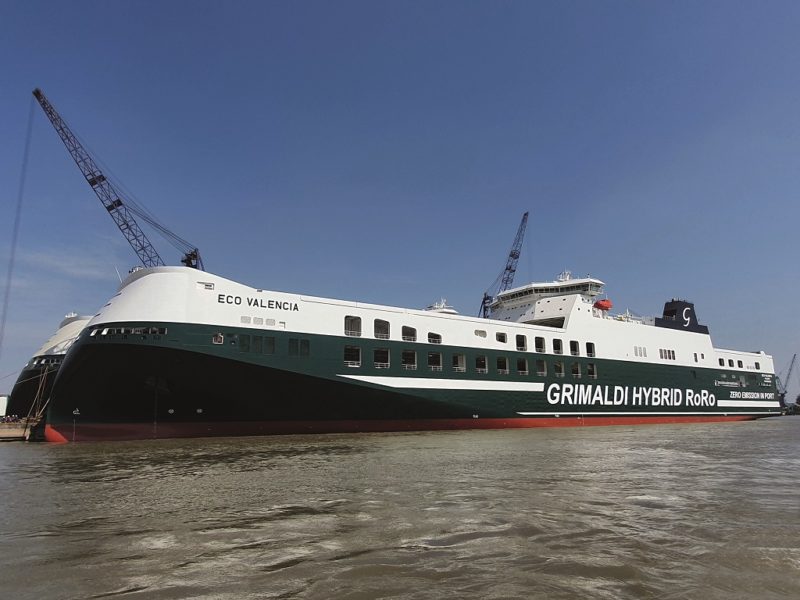
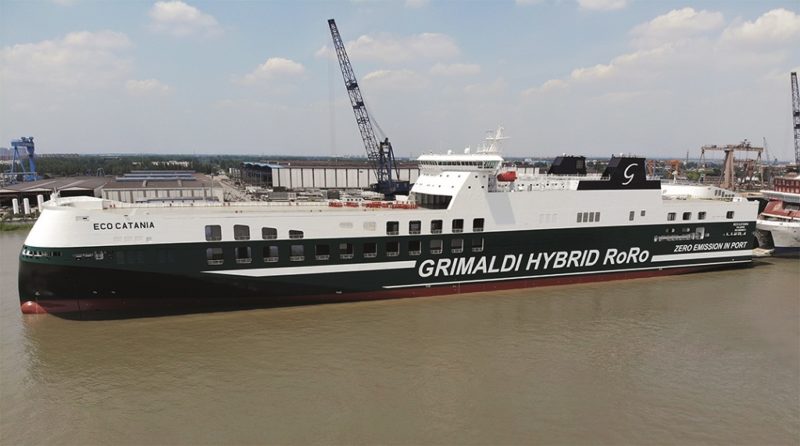
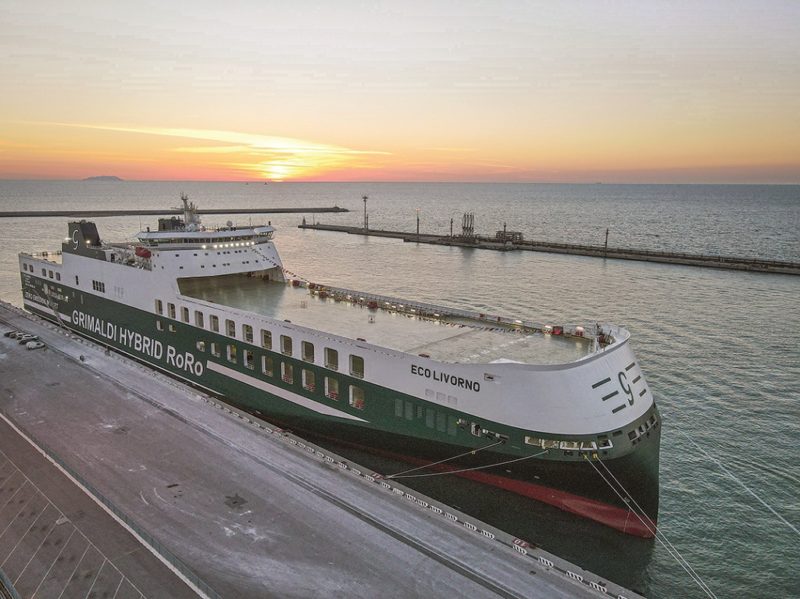
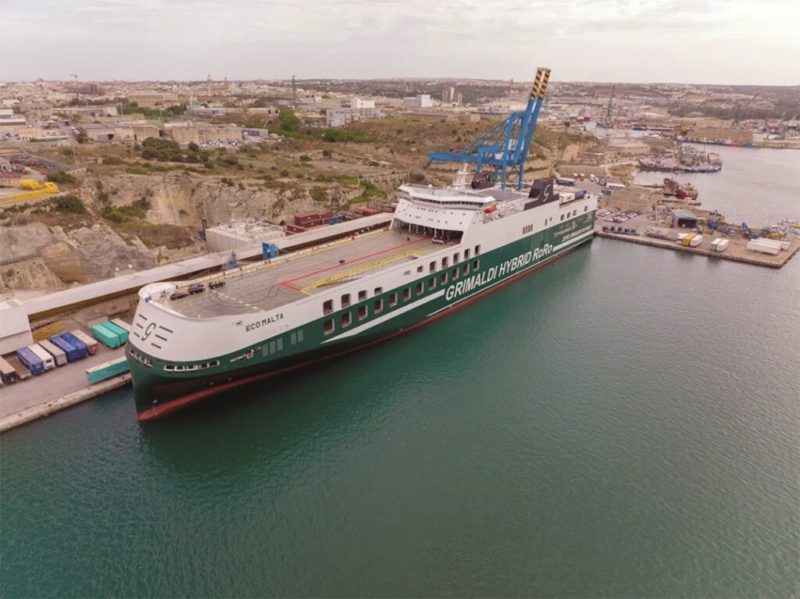
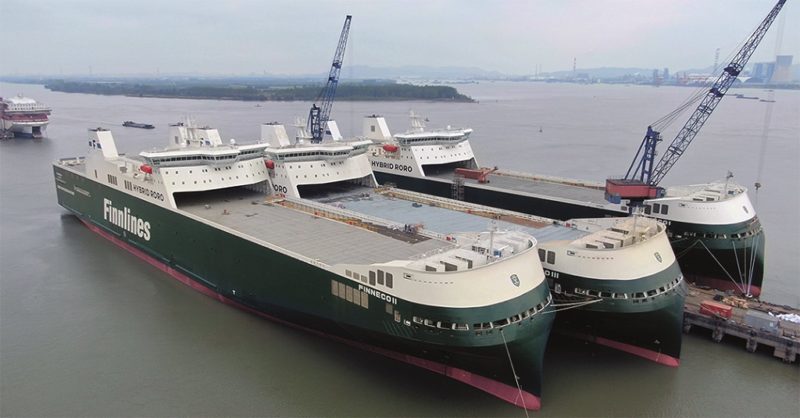
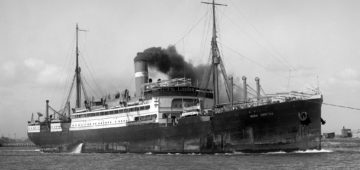



Comments
Sorry, comments are closed for this item